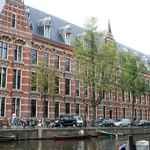Demo Day: Conservation and Restoration Lab
- Date
- 5 June 2025
- Time
- 16:00 -17:00
- Location
- Bushuis/Oost-Indisch Huis
- Room
- Humanities Labs workshop space, F0.01
After a short introduction by Maarten van Bommel, director of the Conservation and Restauration Lab, there will be two presentations by Lucy Clift (PhD candidate) and dr. Ana Albano Serrano (Assistent professor textile conservation).
Speaker 1: Lucy Clift (PhD candidate)
How to Grow a Lead Soap: Relevant systematic parameters for the formation of metal soap protrusions
Metal soap protrusions are a point of concern for paintings conservators, as they threaten the visual and mechanical stability of artworks. Project Protrusion aims to grow lead soap protrusions on a short timescale whilst remaining comparable to those found in naturally aged oil paintings. To this end, this research will produce candidate models for exploring different factors that have been hypothesised to promote the formation of metal soap protrusions. By systematically investigating the influence of paint composition, environmental factors, and conservation treatments on protrusion formation we aim to provide crucial insights into the history and optimal conservation strategies for affected paintings. This presentation presents the results of initial model studies investigating the effects of paint preparation, layer, composition, and environmental conditions on lead soap protrusion formation under accelerated aging conditions.
Speaker 2: Dr. Ana Albano Serrano (Assistent professor textile conservation)
Black Magic – (Re)discovering the development and changes of black woollens quality standards in the 18th-century Leiden's staalmeesters sample books
Following the award of a NICAS-NWO grant, this project will focus on a unique collection of sample books (1690-1791), with hundreds of black wool samples produced in Leiden, and belonging to the Museum De Lakenhal. Leiden followed strict regulations and used several grades to control the quality of its black woollens, which were often meant for export. Yet, the samples for each quality grade vary considerably, suggesting that this control was not as standardised as initially assumed. A PhD and a postdoc will study these books and their wool samples, with the aim to (re-)discover the development and changes of 18th-century Leiden quality-control standards, and establish the city’s role in the globalisation of trade in textiles and textile materials
